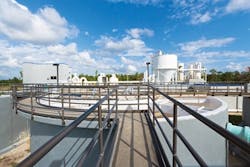Lighting: LED Retrofitting Aids Wastewater Treatment Plants
Hazardous environmental applications traditionally have used three types of high-intensity discharge lighting—high-pressure sodium, fluorescent and metal halide.
A fourth option is light-emitting diode (LED) technology, which has no filaments or fragile housings that can break during operation. Instead of heating a filament or using a combination of gases to produce light, LEDs use semi-conductive materials that illuminate when electric current is applied. LEDs require no warm-up or cool-down time before re-striking, and provide instant illumination when powered on. They can withstand extreme heat and cold, as well as vibration. The increased visibility provided by the pure light LEDs produce increases security and safety.
Several wastewater plants have converted their lighting to LEDs, and the lights are expected to last more than 10 years. The fixtures draw, on average, less than half the wattage of high-pressure sodium and mercury vapor, so operating costs are reduced over the life of the upgrade. LEDs combine ultra-high efficiency with reliable performance and a longer life span in an increasingly affordable package.
Retrofitting existing plants is not an issue, because most of the lights use existing wiring, making the installation process simple. The process usually takes less than an hour per fixture.
Download: Here
